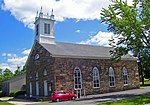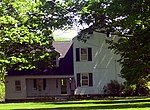Highland Lakes State Park
1964 establishments in New York (state)Hudson Valley, New York geography stubsPalisades Interstate Park systemParks in Orange County, New YorkProtected areas established in 1964 ... and 2 more
State parks of New York (state)Use mdy dates from August 2023

Highland Lakes State Park is a 3,115-acre (12.61 km2) undeveloped state park in the towns of Wallkill and Crawford in Orange County, New York, United States. The park is located northeast of the city of Middletown, west of Route 211. It is the largest undeveloped park managed by the Palisades Interstate Park Commission.
Excerpt from the Wikipedia article Highland Lakes State Park (License: CC BY-SA 3.0, Authors, Images).Highland Lakes State Park
Tamms Road, Town of Wallkill
Geographical coordinates (GPS) Address Nearby Places Show on map
Geographical coordinates (GPS)
| Latitude | Longitude |
|---|---|
| N 41.5096 ° | E -74.3236 ° |
Address
Tamms Road 274
10941 Town of Wallkill
New York, United States
Open on Google Maps










